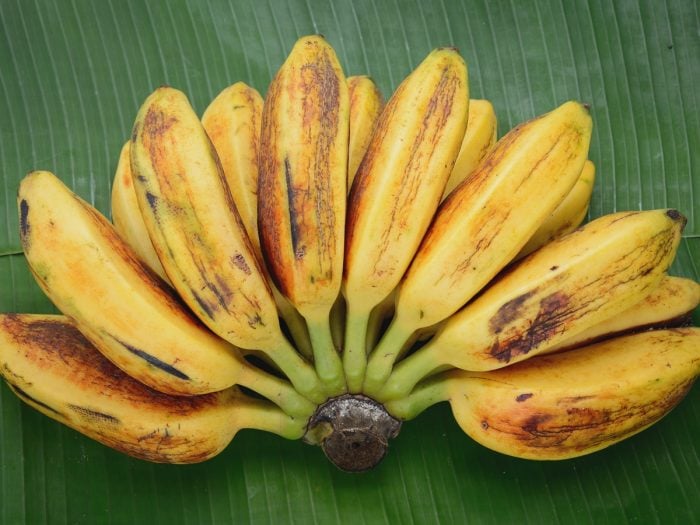If you are looking for a unique banana cultivar, saba banana is for you! It is a hybrid that is primarily cultivated in the Philippines and is now growing in popularity around the world as its distribution increases. The nutritional and physical characteristics of saba banana are similar to banana and plantain. But there are a few differences as well.
What is a Saba Banana?
A saba banana is known as a triploid hybrid of a traditional banana and is primarily used in cooking in the Philippines and other South Asian nations. It can also be eaten raw if you want to enjoy the full nutritional benefits. Sometimes referred to as a cardaba banana, the fruit has the traditional yellow exterior and peel, but it is blocky and square in terms of shape and is also smaller than most bananas. [1]
These fruits grow on large pseudostems and a bunch can bear anywhere from 55-80 pounds of fruit. Scientifically known as Musa acuminata x balbisiana, the white flesh is similar to most bananas, but the fruit is denser and is used most often in traditional desserts. These fruits grow to between 3 and 5 inches and are typically harvested when the peel is still a deep green.
Saba Banana vs Plantain
Although plantains are closely related to saba bananas, they are differentiated by their genetic makeup. Saba bananas and plantains bring a rich taste to your plate when cooked, more than when eaten raw. Both of these banana cultivars are also triploids, referring to their genetic makeup, although Saba bananas have an ABB genetic makeup, and plantains typically have an AAB makeup. Their size is quite similar, making it easy to confuse the two, but the shape of saba bananas sets them apart, as plantains lack the angular aspect of saba bananas. [2]

Did you know that saba bananas are from Philippines? Photo Credit: Shutterstock
Saba Banana Nutritional Facts
Saba bananas contain a rich blend of nutrients and vitamins, including B vitamins, dietary fiber, vitamin C, vitamin A, and iron. These small banana cultivars also contain roughly 120 calories per fruit. They are primarily composed of starchy carbohydrates and provide no fat or cholesterol. [3]
Saba Banana Health Benefits
Some of the most impressive health benefits of saba bananas may include their ability to improve digestion, regulate circulation, lower blood pressure, improve metabolic processes and strengthen the immune system.
May Aid in Digestion
With a solid concentration of dietary fibers, saba bananas are excellent for digestion. They can be able to speed up peristaltic motion to overcome symptoms of constipation, and may also reduce the risk of gastric ulcers and other gastrointestinal issues. [4]
May Improve Metabolism
With a number of different B vitamins in saba bananas, these unique fruits are able to improve metabolic processes in the body, including those that are related to energy metabolism. They can also provide an energy boost when eaten raw and can aid in nervous system function. [5]
May Help Boost Immunity
These bananas possess a high concentration of vitamin C, with nearly 40% of your daily requirements provided in a single fruit. Intake of saba banana can help to kick-start the immune system and protect your system from infections, along with boosting antioxidant activity in the body. [6]
May Stimulate Circulation
Boasting a possibly high level of iron, these banana cultivars can help to stimulate circulation. Iron is an essential component of hemoglobin, which may help to deliver oxygen and resources to the areas of the body that need it most. [7]
